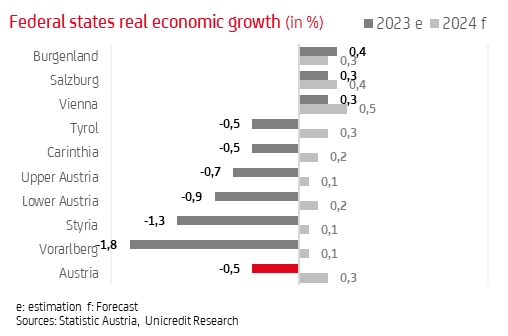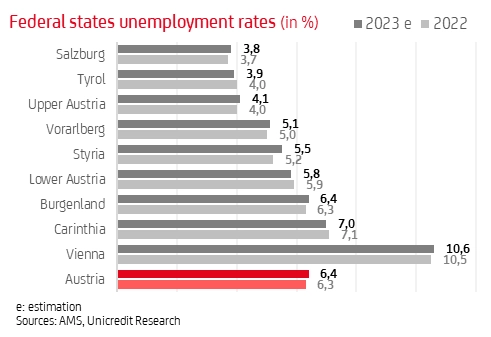UniCredit Bank Austria analysis of the economies of the federal states for 2023 and outlook for 2024
2023 sees decline in growth in all federal states – states with strong focus on industry most affected
- After strong growth in all federal states the year before, regional economic output improved very little or even declined in most states
- Industry-focused federal states experience headwinds for second consecutive year
- Burgenland records strongest growth in 2023, followed by Salzburg and Vienna
- Vorarlberg and Styria suffer highest decline in regional product output
- Positive momentum from tourism, information technology and public sector in most federal states in 2023
- Industry, construction, transport and trade record decline in economic output most regions in 2023
- Overnight stays for 2023 as a whole reach new heights and expected to be around 154 million, exceeding previous record set in 2019
- Capital city Vienna achieves strongest employment growth in 2023
- Labour market in federal states remains robust despite difficult economic environment
Following an increase in economic output of well over 3% in all federal states in 2022, with two states even recording growth of almost 10%, there was a significant slowdown in the regions this year. As in the previous year, industrial regions were more disadvantaged by economic development in 2023. The capital goods industry and the construction sector were hit hardest by sharply rising prices and weak global demand due to multiple crises. In most federal states, positive momentum came from tourism, real estate and the public sector.
"Across Austria, we expect GDP to fall by 0.5% in 2023, followed by a moderate recovery driven by consumption with growth of 0.3% in 2024", says UniCredit Bank Austria Chief Economist Stefan Bruckbauer, adding: "The difficult market environment in the various sectors in 2023 was reflected accordingly in the economic development of the individual federal states. The federal states with a relatively strong emphasis on services had an advantage over the more industrial-focused regions. Nevertheless, none of the federal states recorded economic growth of more than 1% this year."
Burgenland with strongest growth, Vorarlberg with largest decline
The two smallest federal states, Burgenland and Vorarlberg, are leading and trailing in the federal state rankings. "Burgenland with 0.4%, followed by Salzburg and Vienna with 0.3% each, recorded weak positive growth in 2023 with their relatively high weighting on services", says UniCredit Bank Austria Economist Robert Schwarz, adding: "All the other federal states suffered a decline in their economic output." In the regions of Tyrol and Carinthia, the economy shrank by 0.5% in line with the national average. This is followed by states with a strong focus on industry. In Upper and Lower Austria, economic output fell by 0.7% and 0.9% respectively. Styria and Vorarlberg bring up the rear with -1.3% and -1.8% respectively.
Robust labour market nationwide despite weak economy
Following a decline in the unemployment rate in all federal states in 2021 and 2022, the regional labour markets proved to be very resilient this year despite the economic slump. "None of the federal states recorded a sharp rise in unemployment for 2023 as a whole", says Schwarz, adding: "Tyrol and Lower Austria are expected to record lower annual average unemployment than in 2022." As in the previous year, Salzburg has the lowest unemployment rate at 3.8%. Despite very strong growth in employment in all federal states, Vienna remains the region with the highest unemployment at an average rate of 10.6% in 2023.
Recession in industry and construction
After two years of strong value-add growth, industry recorded a sharp decline in real economic output of around 3% this year. Vorarlberg, Styria and Lower Austria experienced the biggest slump in their industrial economies, with a drop in industrial value added of around 5%. Salzburg and Burgenland fared better and were able to avoid an industrial recession with shrinking value added. With value added expected to fall by 2% this year, the economic picture in the construction industry was just as bleak as that in the material goods sector. The western states of Vorarlberg, Tyrol and Salzburg were hit disproportionately hard by the sharp slowdown, particularly in housing construction. The construction industry in Styria was relatively robust.
The weak economic situation was also reflected in foreign trade statistics. Despite the sharp rise in prices, goods exports are expected to rise only slightly to EUR 197.5 billion in 2023 as a whole. Exports of machinery and pharmaceutical products were relatively strong, with the states of Upper Austria, Vienna and Tyrol benefiting in particular. In contrast, there was a sharp drop in exports of wood and paper, which had a particularly negative impact on the balance of foreign trade in Salzburg, Tyrol and Carinthia.
Slight growth in services sector
In contrast to industry and construction, the Austrian services sector saw a slight increase in estimated value added in 2023 compared to 2022. Overall, tourism, information technology and the public sector recorded a solid increase in economic output. That said, the weak industrial economy and declining consumption to due to sharply rising prices had a negative impact on development in the transport and retail sectors. "Led by tourism, the tertiary sector was the biggest growth driver, especially in Vienna, Salzburg and Tyrol; while the services sector in Upper Austria and Carinthia shrank significantly in 2023", says Schwarz, adding: "For 2023 as a whole, we expect overnight stays in Austria to rise to a new record of around 154 million overnight stays."
Outlook for 2024: Slight recovery expected in all federal states
UniCredit Bank Austria economists expect a moderate recovery to start in Austria in 2024, with a slight increase in Austrian GDP of 0.3% based on a further decline in inflation. "Due to consistently robust demand in tourism and higher consumption thanks to rising real wages, services-focused federal states such as Vienna and Salzburg will continue to outperform industrial states such as Styria and Upper Austria in 2024", says Schwarz. After the labour market in the federal states proved to be very robust in 2023, economists at UniCredit Bank Austria expect the unemployment rate in Austria to rise to an average of 6.7% in 2024, up from 6.4% in 2023. Unemployment is expected to rise in all federal states, with a higher-than-average increase in federal states that concentrate mainly on industry.


Enquiries:
UniCredit Bank Austria Economics & Market Analysis
Robert Schwarz, Tel. +43 (0) 50505 - 41974;
Email: robert.schwarz@unicreditgroup.at


